page 20
Progressive Thinkers as of 5/8/2020
|
| ||||||||||||||||||||||||||||||||||||||||||||||||||||||||||||||||||||||||||||||||||||||||||||||||||||||||||||||||||||||||||||||||||||||||||||||||||||||
Here is an extremely short list of three-patterned ideas culled from an earlier collection: Buckland's Third Revolution Poster column 5:
| St. Augustine's Philosophy: | Memory ~ Understanding ~ Will |
| Comte's Philosophy: | Great Being ~ Great Medium ~ Great Fetish |
| Hegel's 3 Spirits: | Subjective Spirit ~ 0bjective Spirit ~ Absolute Spirit |
| Plotinu's Philosophy: | One ~ One Many ~ One and Many |
| Aristotle's 3 Unities: | Unity of Action ~ Unity of Time ~ Unity of Place |
| Sir F. Bacon's 3 Tables: | Presence ~ Absence ~ Degree |
| Thomas Hobbes's 3 Fields: | Physics ~ Moral Philosophy ~ Civil Philosophy |
| Immanuel Kant's 3 Critiques: | Pure Reason ~ Practical Reason ~ Judgment |
| Averroes's 3 Commentaries: | Little ~ Middle ~ Great |
| Karl Marx's 3 isms: | Communism ~ Socialism ~ Capitalism |
| Woodrow Wilson's 3 isms: | Colonialism ~ Racism ~ Anti-Communism |
| Hippocrates's Mind Disorders: | Mania ~ Melancholia ~ Phrenitis |
| Emile Durkeim's 3 Suicides: | Egoistic ~ Altruistic ~ Anomic |
| D. Liesman's 3 Social Characters: | Tradition-directed ~ Inner-directed ~ Other-directed |
| Erich Fromm's 3 Symbols: | The Conventional ~ The Accidental ~ The Universal |
| Pythagoras's "fusion" idea: | Monarchy ~ Oligarchy ~ Democracy (into harmonic whole) |
| M.L. King Jr.'s "Middle Road": | Acquiescence ~ Nonviolence ~ Violence |
| Kierkegaard's 3 Stages: | Aesthetic ~ Ethical ~ Religious |
| Husserl's 3 Reductions: | Phenomenological ~ Eidetic ~ Religious |
| St. Augustine's 3 Laws: | Divine Law ~ Natural Law ~ Temporal, or positive Law |
| Witness Stand "Laws": | Tell the Truth ~ The whole Truth ~ Nothing but the Truth |
| Titus Carus's 3 Ages: | Stone Age ~ Bronze Age ~ Iron Age |
| Feuerbach's 3 Thoughts: | God, 1st Thought ~ Reason, 2nd ~ Man, 3rd |
| Magnus's 3 Universals: | Ante Rem ~ In Rem ~ Post Rem |
| Max Weber's 3 Authorities: | Traditional ~ Charismatic ~ Legal-rational |
| F. de Sausure's 3 "Signs": | Sign ~ Signified ~ Signifier |
| Charles Pierces 3 "Signs": | Qualisign ~ Sinsign (token) ~ Legisign |
| John Keynes's 3 Eras: | Scarcity ~ Abundance ~ Stabilization |
| George Mead's 3 Distinctions: | Self ~ I ~ Me |
| Thrasher's 3-group Gangs: | Inner Circle ~ Rank & File ~ Fringers |
| Abe Lincoln's 3-For-All: | Of the People ~ By the People ~ For the People |
| Jesus Christ's 3 Praises: | In the name of the Father ~ Son ~ Holy Spirit |
| Samuel Clemmons' 3 lies: (Mark Twain) |
Lies ~ Damned Lies ~ Statistics |
The idea of a Cognitive Model, much less a "Standard Cognitive Model" needs to be viewed as a label which references a type of language seen expressed in developmental behavior. As such, "language" in the present context is quite broad, since I not only believe all subjects have their own language (aside from the human language labeling being applied). For example, air vibrations called sounds or music, is a type of language. So is the movement of waves on the ocean. But language need not have sound. Speech, more simply labeled as speaking, involves Air, Vibration and Muscle. No less, behavioral development for example, is a language that humans come to label and interpret within the context of a given era of understanding and vocabulary being used for a given subject. But before speech was used for talking as we of today refer to sounds coming out of our mouths, it is generally thought that primitive humans (just like many of us today) rely on both words and gestures to communicate with. Interestingly, it appears that Words and Gestures Are Translated by the Same Brain Regions.
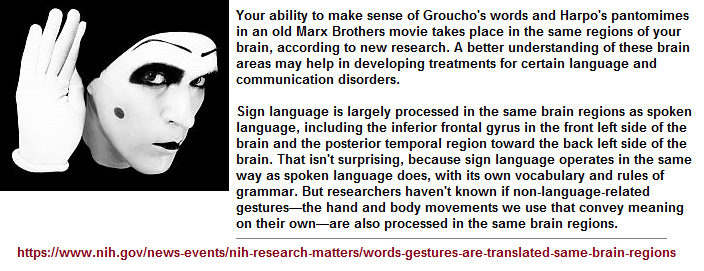
The idea that Mathematics and other subjects have their own respective languages and cultures is not a knew idea. Whether it be the language of a primitive culture just beginning to grasp a concept of counting (1, 2, 3...), or those using highly technical symbols and equations. To this end, simply put, primitive (number) counters of centuries ago had a form of enumeration which differs from the mathematics of today, but both are languages. If we look at physics, the particles and their arrangements is a language we have interpreted with respect to current formulas of ideas and attached labels. Hence, let us say that patterns (and the seeming lack thereof) are an expressed language which humans interpret with respect to knowledge and vocabulary. To this end, the Patterns of Nature, those which we see and overlook, are an expressed language or languages. Humans very often shoe-horn them into relative approximations for a given use; for profit, for ego, for good, for bad, for whatever...
Arrangements of numbers, letters, symbols, sounds, combinations, (or absence thereof), etc., can play a part in formal or informal language. In fact, one person's language can be another person's viewed gibberish or "noise". With this in mind, if we think of recurring patterns (with or without sound), we might decide to call it language, unless one's definition of a language is restricted to vocal utterances of intelligibility. A foreign language for example, can sound like gibberish to someone not familiar with the sounds being uttered, until the patterns become associated (paired) with an idea a person is familiar with. Hence the need for using a broad-based repertoire of metaphor and analogy, so as to invite the possibility that someone's knowledge and experience base may make a connection with material which may be just as broad, in order to attempt a description involving what are believed to be basic recurring patterns which standards of so-called normal human language may have mislabeled, misunderstood, misapplied, etc., and thus create discrete placements which do not allow for a needed broader view to increase one's understanding.
While the idea of a "standard Cognitive model" may be new to some readers, it is not an uncommon idea. However, it takes on different types of referencing with respect to the interest(s) of a given researcher, such as myself with an orientation towards the recurrence of "threes" patterns in different subjects expressed in multiple ways. However, a researcher is quite often oblivious to their usage of a specific pattern and how it compares to other ideas in other subjects they may have little interest in. For example, you may or may not be aware of how often different researchers will use three subjects, three groups of subjects, three tasks, over a "three" (day, week, month, year) period, and that it involves three researchers, three pieces of equipment, or some other valued structure of three, such as within the context of their writing. Hence, I have taken up the task of not only cataloguing various types of "three- patterned" groupings, as well as individual expression thereof, but make note of the absence of such a pattern and which, if any other pattern (number or otherwise) is being used, as a method by which recurring thinking patterns and non-vocalized behaviors can be listed and ranked according to frequency (and infrequency) of occurrence. In such a way, the number values being used in activities and expressions can be used as both a monitoring system and identification of basic cognitive activity which appears to be subjected to a constraint because only a handful of patterns are being used, in comparison to the infinity of numbers at our disposal.
However, just because a biological or anatomical pattern may re-occur, this does not mean Nature is using the pattern for multiple instances to the extent it is being repeated as a basic cognitive pattern. For example, "There are typically around 270 bones in human infants, which fuse to become 206 to 213 bones in the human adult." (Anatomy, Bones by Paul T. Cowan & Preet Kahai.) Such number patterns are not frequently encountered in different subject contexts. While one may encounter a pattern that is thought to be significant in a given context, the same pattern may not have a widespread presence in another or multiple subjects. Some number patterns are more prominent than others. However, in acknowledging the presence of different number patterns, some researchers leave this observation as it is, without further clarifying the numbers in relationship to one another. For example, one may see a primary-secondary-tertiary sequence labeled as one- two- three, A-B-C, 1st- 2nd- 3rd, mono- bi/di- tri, xyz, etc...,in the context of a developmental sequence such as the Three Germ layers (Mesoderm- Ectoderm- Endoderm), and not seek to apply the idea of a developmental progression in a non-biological context, where a seemingly inorganic idea (such as Mathematics apparently using a predominant fixation on patterns-of-two), is not considered to be a primitive developmental sequence of (organic-driven) brain activity. In other words, the predominant usage of patterns-of-two (dualities/dichotomies) in Mathematics can not be seen as if it were a primitive life form with two germ layers.
At this point, permit me to offer 3 examples of different cognitive model ideas which may or may not imply the presence of an underlying standard. It should also be understood that I am presently looking at the idea of a "standard" cognitive model in much the same manner as I observe the presence of a present-day standard anatomy such as the Pentadactyl limb, but that in an earlier time period such as the Devonian period, it has been found that (at least in the fins of fishes, the standard involved either (one of three) 6, 7 or 8 digits called Polydactyly in stem-tetrapods). In other words, environmental pressures created conditions ripe for adaptations generally described as Evolution, whether or not you like the word because you have come to associate it with some adolescent -linked argument involving some ridiculous religious orientation.
Pentadactyl: Many vertebrates have a very similar bone structure despite their limbs looking very different on the outside. This structure is known as the Pentadactyl (five fingered) limb. This suggests that many vertebrates descended from the same common ancestor. Although the limbs of crocodiles, birds, whales, horses, bats and humans all look very different they share the same five fingered bone structure. This provides evidence for the theory of evolution.
Polydactyly Polydactyly in stem-tetrapods should here be understood as having more than five digits to the finger or foot, a condition that was the natural state of affairs in the very first stegocephalians during the evolution of terrestriality. The Polydactyly in these largely aquatic animals is not to be confused with Polydactyly in the medical sense, i.e. it was not an anomaly in the sense it was not a congenital condition of having more than the typical number of digits for a given taxon. Rather, it appears to be a result of the early evolution from a limb with a fin rather than overtly expressed digits such as exhibited by the human hand.
Comparing feet/hands of different species, noting that such appendages are dynamically used in conjunction with terrains, and foodstuffs as well as (if used for fighting and other) specialized adaptations; presents us with an occasion in which numbers can be used to identify both similarities; and then attempt some correlational association with numerically identifiable qualities of human behavior noted as vocalizations (language) and ideas. If we place the idea of a time-line with respect to changes taking place with the quantity of toes/fingers (digits), we can recognize an increase in quantity as we go further back in time which should be associated with incrementally over time -gross changes in the environment such as the irradiation of the Sun, slowing of the Earth's rotation rate and the receding of the Moon... all of which make marked alterations (over time) and force life forms to adapt to; providing us with an opportunity to measure such changes and quite possibly provide for a crystal ball-like premonition of future events; if not help to identify currencies of activity which may suggest environmental specificities which chain a species to a given formula of environmental activity such as suggested by the idea that we ask: Are Humans Rotation Rate Specific (tide to the rotation rate of the Earth and can not adapt to large changes?)
Simply put, does the human brain, the human mind (from its early evolutionary beginnings) exhibit an identifiable patterning, and is that patterning not only consistent with basic patterning seen in biological substrates (such as pairing in amino-acids and the triplet code of DNA, four limbs, etc....), but anatomical divisions which involve numerically identifiable patterns such as (List of Three's in Anatomy by Dr. McNulty and Associates), and the largely dualistic referencing used in Anatomical Position and Directional Terms by Courtney Smith, 9/30/19. Whereas there may be vestigial cognitive remnants and ideas about such viewed by some as perpetually speculative, can we use enumeration to detect a current profile of cognitive standardization stripped of its cultural embellishments which sometimes adulterate labels, interpretations and definitions? For example, while different people may refer to a building with a different label based on usage (tool shed, tool box, bread box, temple, garage, house, building, church, skyscraper, etc.,), all of them (in this array) use four corners; and architectural speaking, have a corner-stone, whereby we have a three-to-one ratio because the other three corners are not typically given alternative names. Much like the situation we see in baseball where the so-called th base is largely recognized with the moniker of "Home plate" or "Home base", whereas the other 3 are identified numerically as "1st base, 2nd base, 3rd base". If we take the idea of a Three to One ratio to heart as an analytical tool, we come to find its presence in multiple circumstances, not all of which have moved away from using a "4, four, fourth" designation, but nonetheless exhibit the same 3-to-1 cognitive patterning.
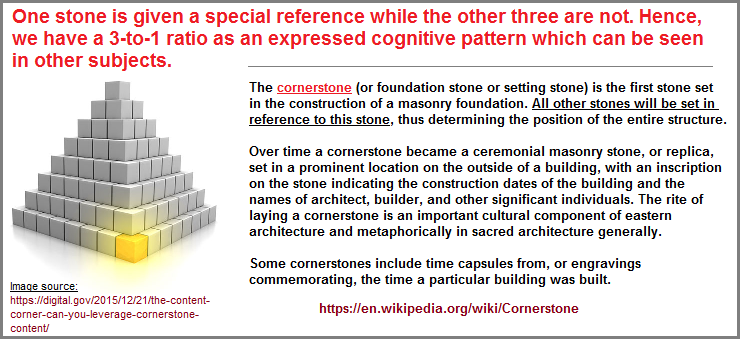
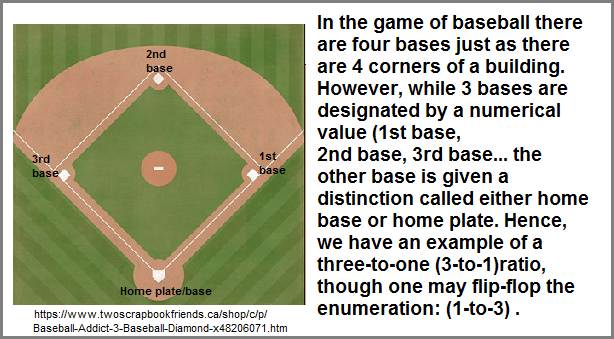
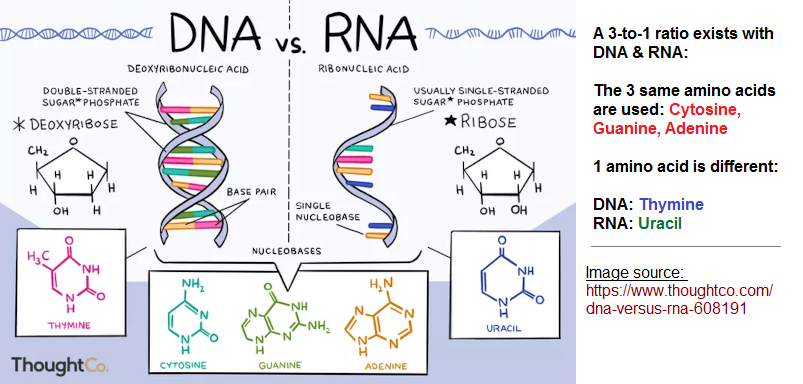
One might also conceive of a 3-to-1 "cornerstone" view of the four elements described by those interested in the Zodiac, though there is an apparent inclination for the four to be interpreted in a binary fashion with respect to compatibility amongst people.
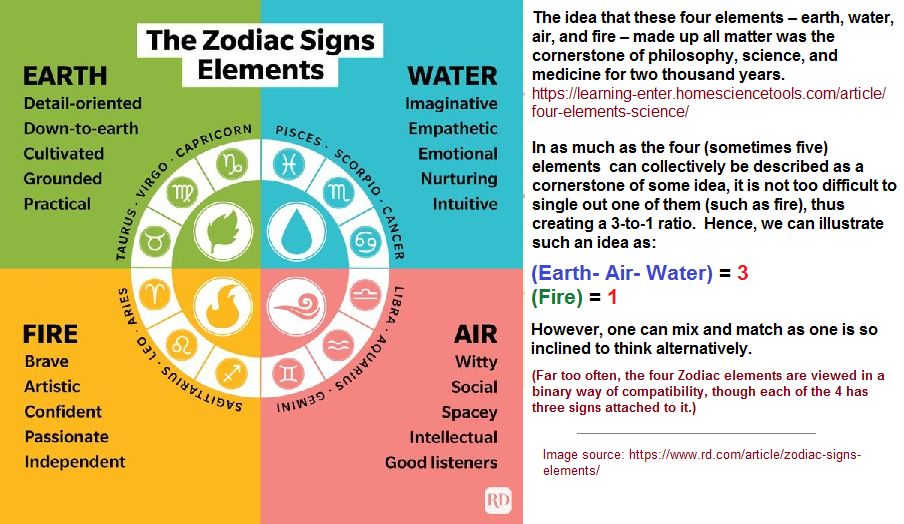
Gross anatomy can be subdivided divided into three different fields: (Defining Anatomy 1.1A)
- Surface anatomy (or superficial anatomy) is the study of external anatomical features without dissection.
- Regional anatomy focuses on specific external and internal regions of the body (such as the head or chest) and how different systems work together in that region.
- Systemic anatomy focuses on the anatomy of different organ systems, such as the respiratory or nervous system.
Just as we see standards of development in overt physiology which (apparently) are derived from a similar source of underlying structural activity, one must wonder if we can do the same for human thinking or mental activity, otherwise known as cognition. And no, this does not mean we can clearly associate the idea of eating a popsicle or ice cream cone with some past vestigial representation seen on a cave wall or illustrated in some primitive tool working. However, there may be basic pre-cursive mental activity which allows for the conceptualization of present day orientations; from which might be derived from some measure of comparison (however speculative), if we can come to agree upon which analytical tool might enable us to do so.
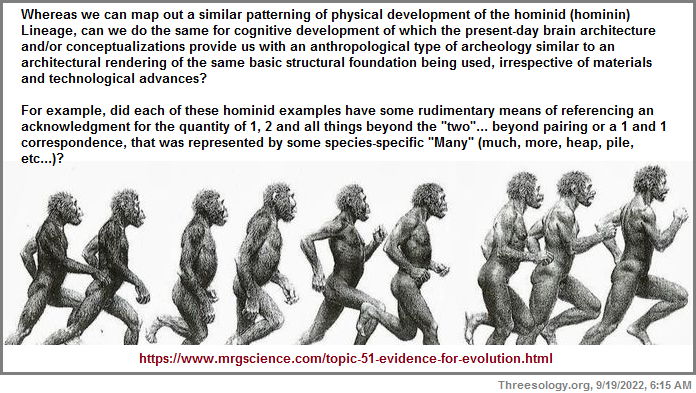
Using the present day standard of a Pentadactyl limb as an analogically-used representation of cognitive development, the thought of such may at first appear to be wild speculation not conducive to any current model of deductive reasoning consistent with the proposed Scientific Method:
The scientific method is an empirical method of acquiring knowledge that has characterized the development of science since at least the 17th century (with notable practitioners in previous centuries). It involves careful observation, applying rigorous skepticism about what is observed, given that cognitive assumptions can distort how one interprets the observation. It involves formulating hypotheses, via induction, based on such observations; experimental and measurement-based statistical testing of deductions drawn from the hypotheses; and refinement (or elimination) of the hypotheses based on the experimental findings. These are principles of the scientific method, as distinguished from a definitive series of steps applicable to all scientific enterprises.
Just as we can find different variations as to the number (quantity) of steps involved in the creative process, so can we find different variations as to what is meant by the Scientific Method, all of which should be noted as expressions of conserved cognitive activity... (In other words, we do not see the quantity of steps or stages or rules-of-thumb containing large quantities, similar to the conservation of how many digits (toes/fingers) have occurred in different organisms over the long haul of biological development):
Examples of cognitive quantification in Explaining The Creative Process:
- 3 levels (Discovery, Invention, Creation)
- 4 stages (Preparation, Incubation, Illumination, Verification);
- 4 Ps (Person, Product, Process, Press);
- 5 steps (Preparation, Incubation, Illumination, Evaluation, Verification);
- 6 Components (Culture, Attitude, Imagination, Knowledge, Habit, Resources)... + 10 references: [Framing, Connections and combinations, Idea generation and brainstorming, Focused observation, Workspace, Constraints and Pressure, Goals and Games, Collaboration and conflicts, Understanding failure, Dreams and Drive);
- 7 stages (Intention, Incubation, Investigation, Composition, Clarification, Changes, Completion);
- 8 steps (Ask, Learn, Look, Play, Think, Fuse, Choose, Make.)
Examples of cognitive quantification in Explaining The Scientific Method:
- 3 Components {1.4: The Scientific Method - How Chemists Think}: (Observation, Hypothesis, Experiment);
- 3 methods of finding the mean in grouped data (Group method, Step deviation method, Assumed Mean method);
- 3 Types (Descriptive investigations, Comparative investigations, Experimental investigations);
- 4 steps (1) Observation and description of a phenomenon (a concept), (2) Formulation of a hypothesis to explain the phenomenon, (3) Test the hypothesis. If experiments do not confirm the hypothesis, the hypothesis must be rejected or modified (Go back to Step 2), (4) Establish a theory based on repeated verification of the results);
- 5 steps (defining the problem, making observations, forming a hypothesis, conducting an experiment drawing conclusions.);
- 6 steps (Make an observation, Ask a question, Form a hypothesis, or testable explanation, Make a prediction based on the hypothesis, Test the prediction, Iterate: use the results to make new hypotheses or predictions);
- 7 steps (Ask a question, Perform research, Establish your hypothesis, Test your hypothesis by conducting an experiment, Make an observation, Analyze the results and draw a conclusion, Present the findings);
- 9 steps (Ask a question, Perform research, Establish your hypothesis, Test your hypothesis by conducting an experiment, Make an observation, Analyze the results and draw a conclusion, Present the findings, Compare results, Analyze, Report findings, Compare with other experiments);
A constraint... a conservation of cognitive activity takes place in our thinking behavior to limit constructs (of thought processing) much like we find limitations in the presumed counting abilities of animals which can be referred to as Number Sense in Animals. However, if we gather additional examples and permit our imaginations to be open-minded to the idea that Nature itself may well be a type of expressed cognitive activity, (even if this is understood only in the sense of a god-like phenomena with a type of brain to which most humans can readily understand... in other words, if we think of a god as having a brain like we do, in as much as it is described that humans were made in the image of (a) god. Let me take a run at the idea (of Nature as an entity having a brain) with the following questions: Does human cognition follow a similar (though uniquely its own model) of evolutionary change over time that we can also identify numerically? Does human cognition have a basic sequence of development we can mathematically identify, and that this Mathematical sequencing is itself conserved (exhibited sometimes as rationalization)? Does Nature routinely resort to the use of conservation as an expressed representation of adapting to an overall incrementally deteriorating environment and planetary system?
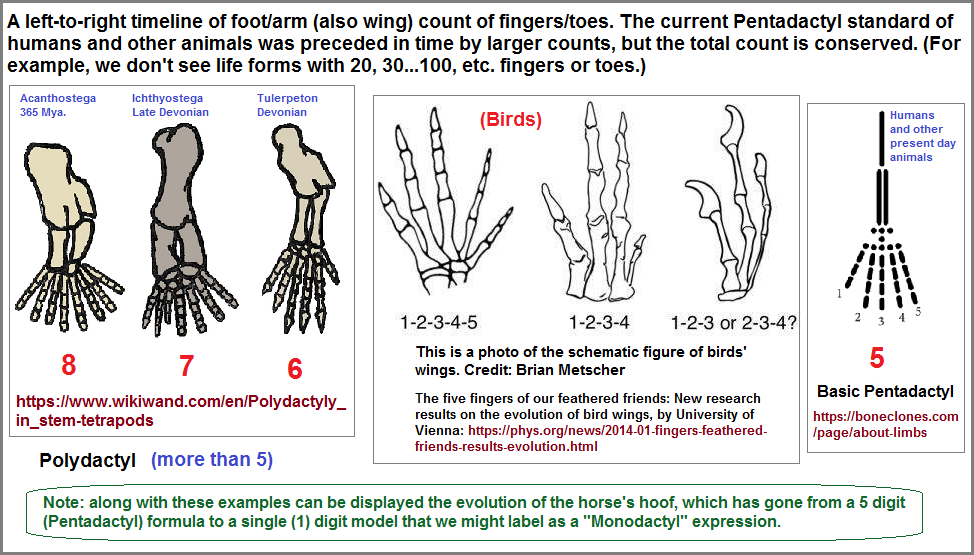
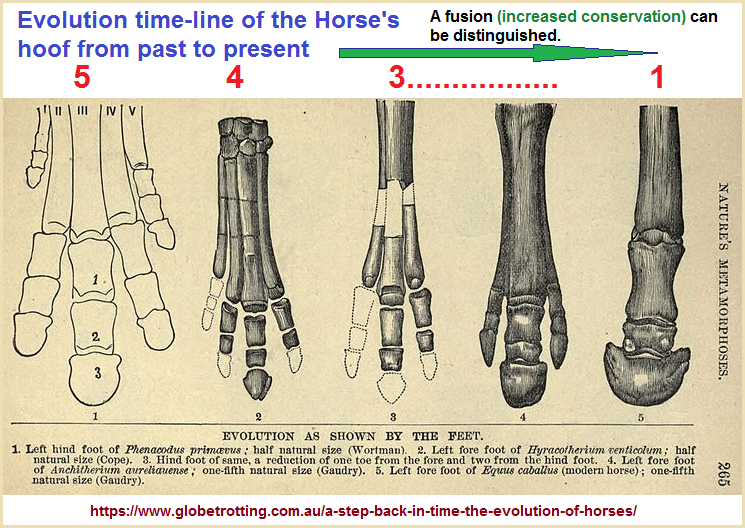
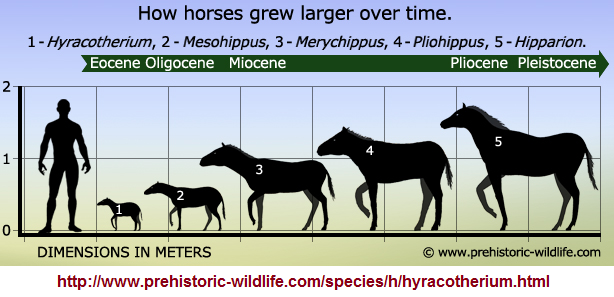
Abstract (The evolution and anatomy of the horse manus with an emphasis on digit reduction by Nikos Solounias, Melinda Danowitz, Elizabeth Stachtiaris, Abhilasha Khurana, Marwan Araim, Marc Sayegh and Jessica Natale, 24 January 2018)
We revisit digit reduction in the horse and propose that all five digits are partially present in the modern adult forelimb. Osteological descriptions of selected Tetradactyl (4 toes/fingers), Tridactyl (3 toes/fingers) and Monodactyl (1 toe/finger) equids demonstrate the evolution of the forelimb. Histological, osteological and palaeontological evidence suggest that the Equus distal forelimb is more complex than traditionally conceived. The current understanding is that the horse distal forelimb consists of one complete digit (III) and two reduced splint metacarpals (II and IV). Metacarpals II and IV each exhibit a ventral ridge, which we suggest represents the undifferentiated digits I and V. These ridges are present in the tridactyl Mesohippus, but are absent in the Tetradactyl Hyracotherium. The carpal articulations of the five metacarpals match those of Pentadactyl taxa. Distally, the frog, a V-shaped structure on the ventral hoof represents digits II and IV, and the wings and hoof cartilages of the distal phalanx are digits I and V. We relate this revised interpretation of the Equus forelimb to Laetoli footprints, and suggest the Hipparion side impressions are created from the hooves of I and V, rather than from II and IV. We show shades of pentadactyly within the Equus manus.
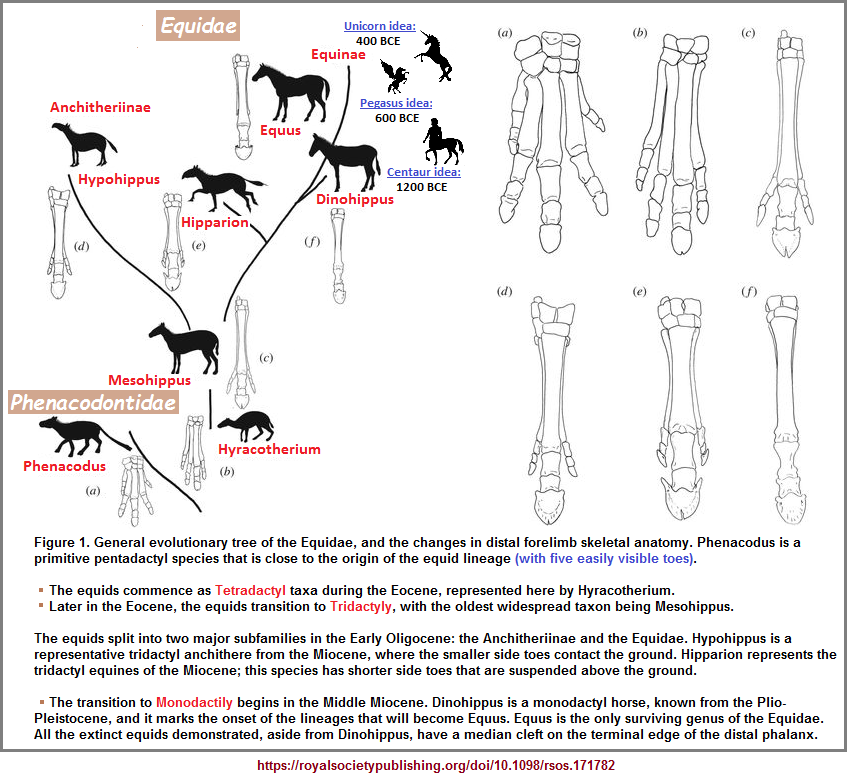
Horse myth Image sources: (Though these Mythological Horse creatures are thought to be not real, what is real is recurring pattern in different formats of illustration, and such creatures apparently recurring in memory. Others include Dragons, Sea creatures, Bird creatures, Shape Shifters, etc...; not to mention the three recurring human forms labeled as Vampires. Werewolves and Zombies, even though their images have been altered since they were originally created. And need I mention Witches, Sorcerers, Demi-gods, etc?)
Note: As an example of a recurring cognitive theme, we have researchers describing the evolution of the horse's hoof containing five digits, and the frequent use of a five horse illustration!
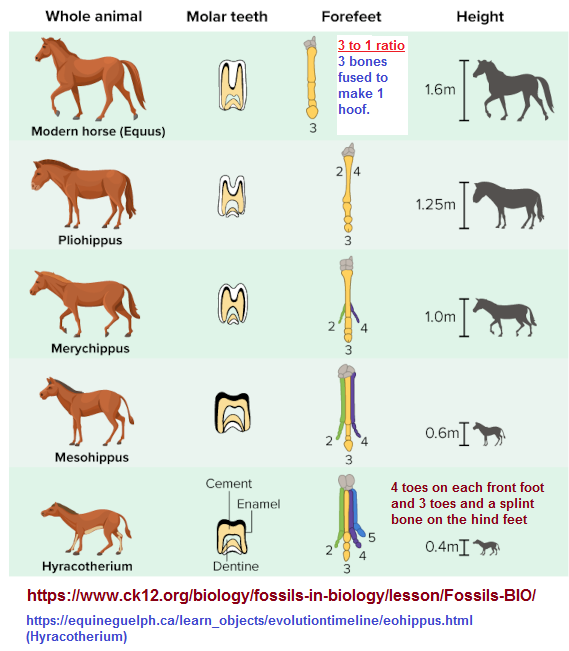
With respect to the foot bones of a horse being described as a process of "fusion" over time (with vestigial remnants of its past are still visible), and correlated with the idea that the human mind can be (in some respects) represent an analogical comparison of development, then the idea of "fusion" or "fusing" of different elements might well be seen. Whereas ancient solar worshipers (called "Pagans") who viewed the Sun as a god (that the Roman Catholic church leadership came to embrace (claim ownership of) within the philosophical confines it could control by labeling and descriptiveness); the Sun's evolutionary direction (degradation and expansion coupled to the Earth's slowing rotation); will increase the already present effect of "fusing" its three phases ("moments" called Dawn-Noon-Dusk), thereby rendering a 3-to-one (3-in-1) fusion that will manifest itself with greater frequency and intensity as life forms continue to adapt to the incremental deteriorations of the planet into the future. However, let me note for the historical record (once again), the "V-shaped frog" of a horse's hoof needs to be viewed in a much expanded realization:
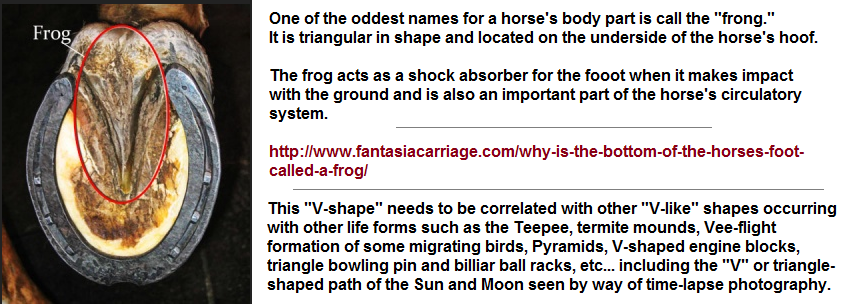
Is the change in the quantity of (toe/finger) digits over time a type of "language" expression used by Nature? And that this expression of conservation is not limited to skeletal changes but also takes place with human cognition which might be numerically identified and viewed as a Cognitive Model? Is the fusion of bones (easily seen in the horse's hoof, a representation of that which is taking place on the cognitive level, such as instead of multiple gods, there is the larger collective concept of a single god, as well as is indicated by the "E Pluribus Unum" phrase which stands for "Out of Many... One" and also relates to the 3-to-1 ratio, where the "3" is sometimes called the "Many" in a primitive counting system (Is "one, two, many" a myth? by Jason Dyer, June 30, 2010). Is the brain still practicing primitive models of associative pairing as an environmentally influenced behavioral form of conservation? (Too many people interested in the history of counting origins don't place the "One, Two, Many" script as both a specificity and as a generality. As a specificity it may relate to one or multiple cultures, and as a generality in terms of being representative of early forms of counting.)
Cognitive Model Example 1
Abstract The Cognitive Model of Cognition (CMC) describes a consensus among many researchers about architectural assumptions that define aspects of human-like minds, whether natural or artificial. This consensus combines ideas from several existing cognitive architectures. Our research group has been developing a theory and an implemented system to do human-like language comprehension within an embodied autonomous agent. This paper analyzes how this theory of human-like language comprehension maps onto the CMC, what extensions to the CMC it might suggest, and what major challenges for the CMC come from applying it to language processing. (The Common Model of Cognition and human-like language comprehension by Peter Lindes.
H.O.B. Note: Like so many others who speak of language, they fail to take into consideration recurring patterns found in hearing. See for example: Language, Hearing, Cognition, and Language Threes page 1. If we take a look at several different theories about language (that is if you take the time to read them), what can be seen is the lack of referencing anything about the process of hearing. One need only look at a deaf person's attempts to articulate spoken language in order to see the importance of hearing is to language, but one after another linguist or educated lay-person excludes looking closely at the patterns to be associated with hearing and those associated with language. So many intelligent people have got their heads stuck in the sand and would make excuses as to why the subject of hearing and the structure of the ear is not included in their theory.
(Second half of this page moved to page 18)
Date of (series) Origination: Saturday, 14th March 2020... 6:11 AM
Date of Initial Posting (this page): 1st March 2022... 6:04 AM
Updated Posting:Saturday, 1st October 2022... 10:05 AM, MST; Albuquerque, NM.